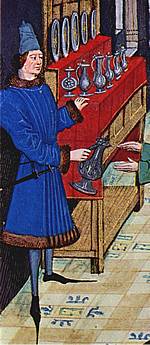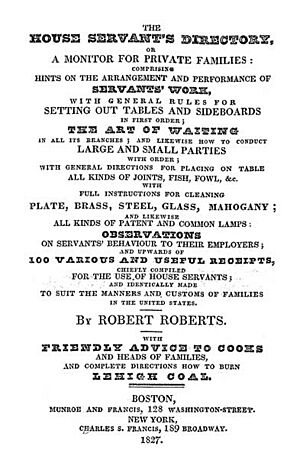Butler facts for kids
A butler is a special kind of helper in a big house. They are usually in charge of the house and other helpers. Think of them as the main manager of the household staff. In the past, butlers were always men and looked after the male servants, while a housekeeper (a woman) looked after the female servants. Back then, male servants often earned more and had a higher position than female servants.
Contents
What Does "Butler" Mean?
The word "butler" comes from an old French word that means "bottle bearer." For many centuries, a butler was the person trusted with looking after and serving wine and other bottled drinks. In ancient times, these drinks were very valuable!
In Britain, butlers started as middle-ranking staff. But over time, especially in the 17th and 18th centuries, they became the most important male servant in the grandest homes. Sometimes, a "steward" was even more senior, managing the estate's money and land, but the butler was still very important inside the house.
Butlers used to wear special uniforms, different from other servants. Today, a butler might wear a business suit or casual clothes, only wearing a uniform for special events.
A "silverman" or "silver butler" is a butler who knows a lot about caring for and cleaning all the silverware and fancy dishes used for special meals.
A Look Back: How Butlers Changed Over Time
The job of a butler has changed a lot! It started with people who were mainly in charge of drinks.
Ancient Times to the Middle Ages
Long ago, drinks were kept in big jars or wooden barrels, not glass bottles. These containers were very valuable. So, only trusted people, often slaves, were given the job of looking after them.
The Bible even mentions a "chief cup-bearer" in ancient Egypt, which was a similar role to an early butler. In ancient Greece and Rome, slaves usually handled the wine. During the Middle Ages, a "pincerna" did this job in noble courts. The word "butler" is linked to both bottles and barrels.
Eventually, the European butler became a middle-level servant. They were in charge of the "buttery," which was a storeroom for drinks. Later, this word meant a general pantry. Butlers who worked for kings or queens had a lot of power and didn't just deal with drinks.
Elizabethan to Victorian Eras
By the 19th century, especially during the Victorian era, the number of butlers grew a lot. The butler became the main male servant in a household. They were in charge of the modern "wine cellar," the "pantry" (where bread, butter, and cheese were kept), and the "ewery" (for washing items). In the biggest houses, a senior "Estate Steward" might oversee the butler.

Butlers were at the top of the servant team. They were more like managers than hands-on workers. For example, a butler would greet a guest, but a footman would open the door. Even so, a butler would help out with any task if needed to keep the house running smoothly.
The house was divided into different areas. The butler was in charge of the dining room, wine cellar, and pantry. Below the butler was the "first footman" or "under-butler." Footmen did many jobs, like serving meals and carrying heavy things. They often also worked as "valets," who helped their employer with personal tasks. Butlers hired and managed all these younger staff. The "housekeeper" managed the house itself and its cleanliness. In smaller homes, the butler often also worked as a valet.
Employers called the butler by their last name, like "Mr. Smith." Other servants called them "Mr. [Surname]" too. Butlers were usually hired by the master of the house but often reported to the lady of the house. Butlers earned a good salary, plus they got a place to live and uniforms. They also often received tips. If a butler was married, their family usually lived somewhere else.
Butlers in Early United States
In the early 1600s, when slavery began in the United States, many African Americans were forced to work as house servants. Some of them became butlers. A historian named Gary Puckrein says that those in wealthy homes learned very refined manners, which made their masters look good.
One of the first books published by an African American was by a butler named Robert Roberts. His book, The House Servant's Directory, came out in 1827. It was a guide for butlers and waiters. It was so popular that it had two more editions!
European indentured servants also worked as domestic helpers, and some became butlers. These people were not slaves, but they often had to work to pay off debts. Their lives depended a lot on how kind their masters were.
The Modern Butler
After World War I (around the 1920s), the number of people working as domestic servants, including butlers, dropped a lot in Europe and the United States. By the mid-1980s, there were only about 100 butlers left in Britain.
However, since the late 1980s, the demand for butlers has grown a lot! This is because the number of very wealthy people has increased around the world. Many of these new millionaires and billionaires want help managing their homes. There's a high demand for butlers, especially in countries like China, India, and the Middle East.
Today, butlers often do many jobs that used to be done by other servants. They might do whatever their employers need to free up their time. A modern butler might manage high-tech systems, look after multiple homes, or even do some housekeeping. Butlers can also work in companies, embassies, on cruise ships, or yachts. Some even have their own "Rent-a-Butler" businesses!
Butler uniforms have also changed. While some still wear traditional uniforms, many now wear more casual clothes, like a polo shirt and slacks in the U.S., or even sarongs in Bali. They might only wear formal business clothes for special events.
By 2007, the number of butlers in Britain had risen to about 5,000. The popular TV show Downton Abbey is even said to have made more people interested in becoming butlers!
How Butlers Learn Their Job
In the past, butlers learned by starting at the bottom and working their way up. For example, a butler might start as a "hall boy" and learn from older servants. This still happens, but now there are also many private butler schools. Graduates from top schools can earn a good salary.
Some fancy hotels, like the Ritz-Carlton, offer traditional butler training. Other hotels have special "pseudo-butlers" for specific tasks, like "technology butlers" who fix computers, or "bath butlers" who prepare custom baths for guests. There are also books and websites to help butlers learn and connect with others in their field.
Girls as Butlers?
Butlers have traditionally been men, and this is still mostly true. However, there are more and more female butlers today! Sometimes, families in the Middle East or Far East prefer female butlers for religious reasons. Western female celebrities might also prefer a woman butler. In 2004, Buckingham Palace (where the British royal family lives) even announced they were looking for women to become butlers.
One butler school reports that about 40% of their students are women. While many employers still prefer male butlers, more and more female butlers are being hired.
In ancient times, being a butler was often a job for slaves. But over time, it became a way for people to move up in society. Today, being a butler can be a very good career choice, even though the job often includes more tasks than it used to.
Images for kids
-
A butler in the White House Butler's Pantry.








